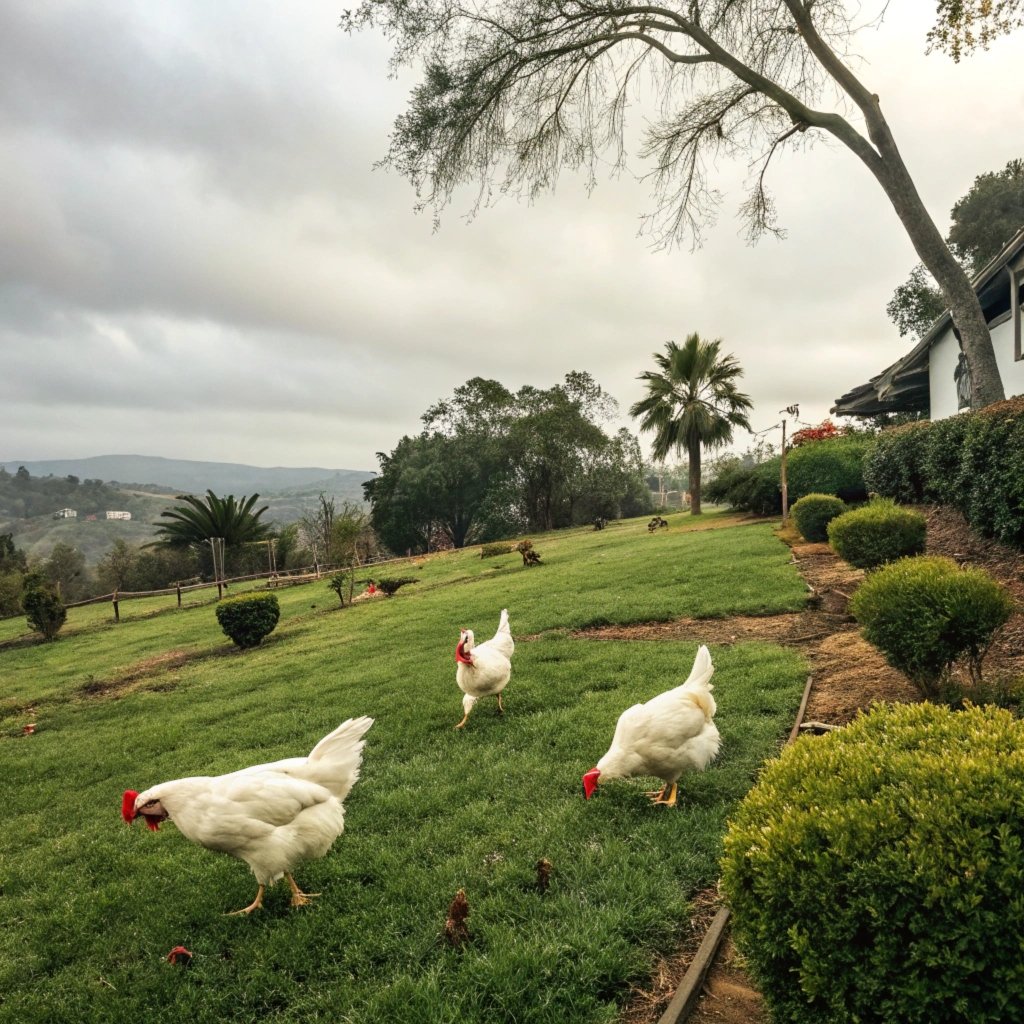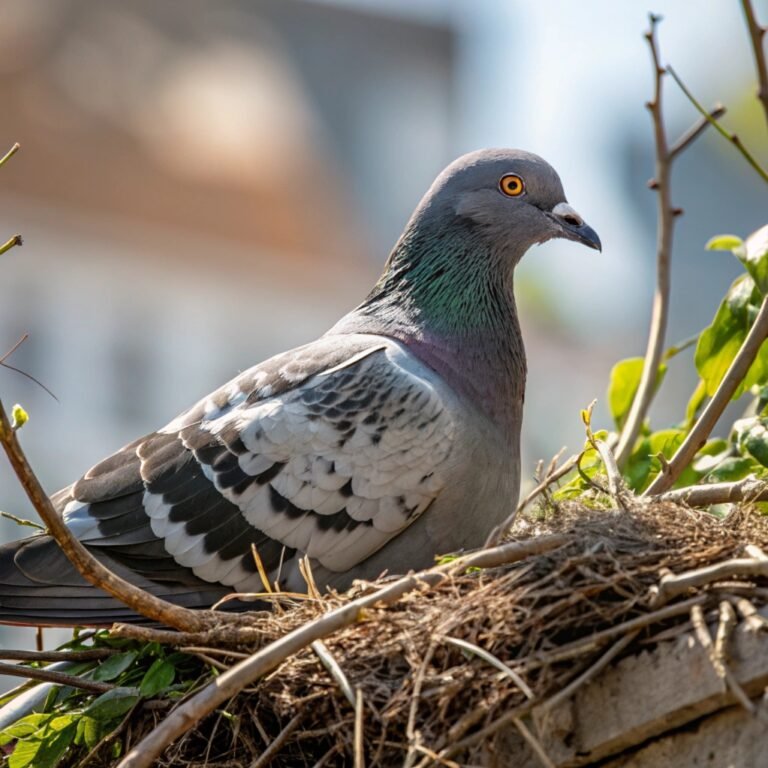California White Chicken: Amazing Rare Breed Revolutionizing Backyard Poultry Farming
The California White Chicken is a remarkable breed that has been making waves in the world of backyard poultry farming.
This unique hybrid, born from the careful crossbreeding of White Leghorn hens and California Grey roosters, has quickly become a favorite among both novice and experienced chicken keepers.
Known for their exceptional egg-laying capabilities, adaptability, and low-maintenance nature, California Whites are revolutionizing the way we think about backyard chickens.
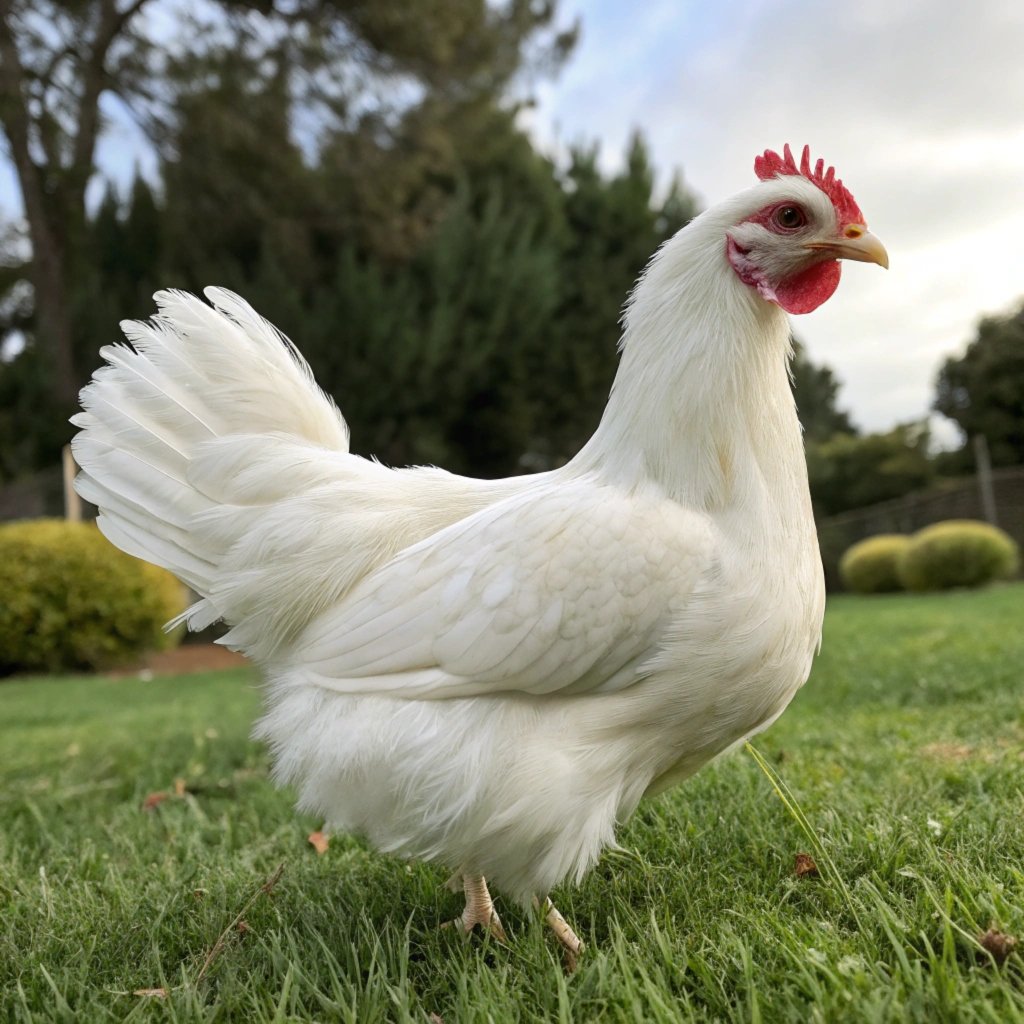
In a Nutshell:
- Exceptional Egg Layers: California White Chickens are prolific egg producers, laying over 300 large, white eggs per year.
- Hybrid Vigor: As a cross between White Leghorns and California Greys, they inherit the best traits from both parent breeds.
- Adaptable and Hardy: These chickens thrive in various climates and housing conditions, from urban backyards to rural farms.
- Low Maintenance: California Whites are generally healthy and easy to care for, making them ideal for beginners and experienced keepers alike.
- Friendly Temperament: While active, they are less flighty than pure Leghorns and can be quite tame with regular handling.
- Efficient Feed Conversion: They produce a high number of eggs relative to their feed consumption, making them cost-effective.
- Medium-Sized: Roosters typically weigh around 7 pounds, while hens are about 5.5 pounds.
- Early Layers: Hens usually start laying around 17 weeks of age, earlier than many other breeds.
- Distinctive Appearance: They have predominantly white plumage with subtle black flecks, large single combs, and an upright stance.
- Versatile: Suitable for both confined spaces and free-range environments, adapting well to various flock management styles.
- Economic Benefits: Their high egg production makes them excellent for personal consumption or small-scale egg sales.
- Quiet Nature: Generally quieter than many other breeds, making them suitable for urban or suburban settings.
- Long-Laying Lifespan: With proper care, they can maintain good egg production for several years.
- Not a Pure Breed: As hybrids, they don’t breed true, which can present challenges for those interested in breeding.
- Future Potential: Their efficiency and adaptability position them well for the future of backyard and small-scale poultry farming.
The Fascinating Origins of California White Chickens
The story of the California White Chicken begins with a quest for the perfect egg-laying machine.
Poultry breeders sought to combine the prolific egg production of the White Leghorn with the hardiness and adaptability of the California Grey.
The result was a hybrid breed that inherited the best traits from both parent lines. This careful selection process has given us a chicken that not only lays an impressive number of eggs but also thrives in various environments.
The California White is a testament to the art and science of selective breeding, showcasing how human ingenuity can create a bird that meets the demands of modern poultry keeping.
While not recognized by the American Poultry Association due to its hybrid status, the California White has earned its place in the hearts of chicken enthusiasts worldwide.
Physical Characteristics: The Distinctive Look of California Whites
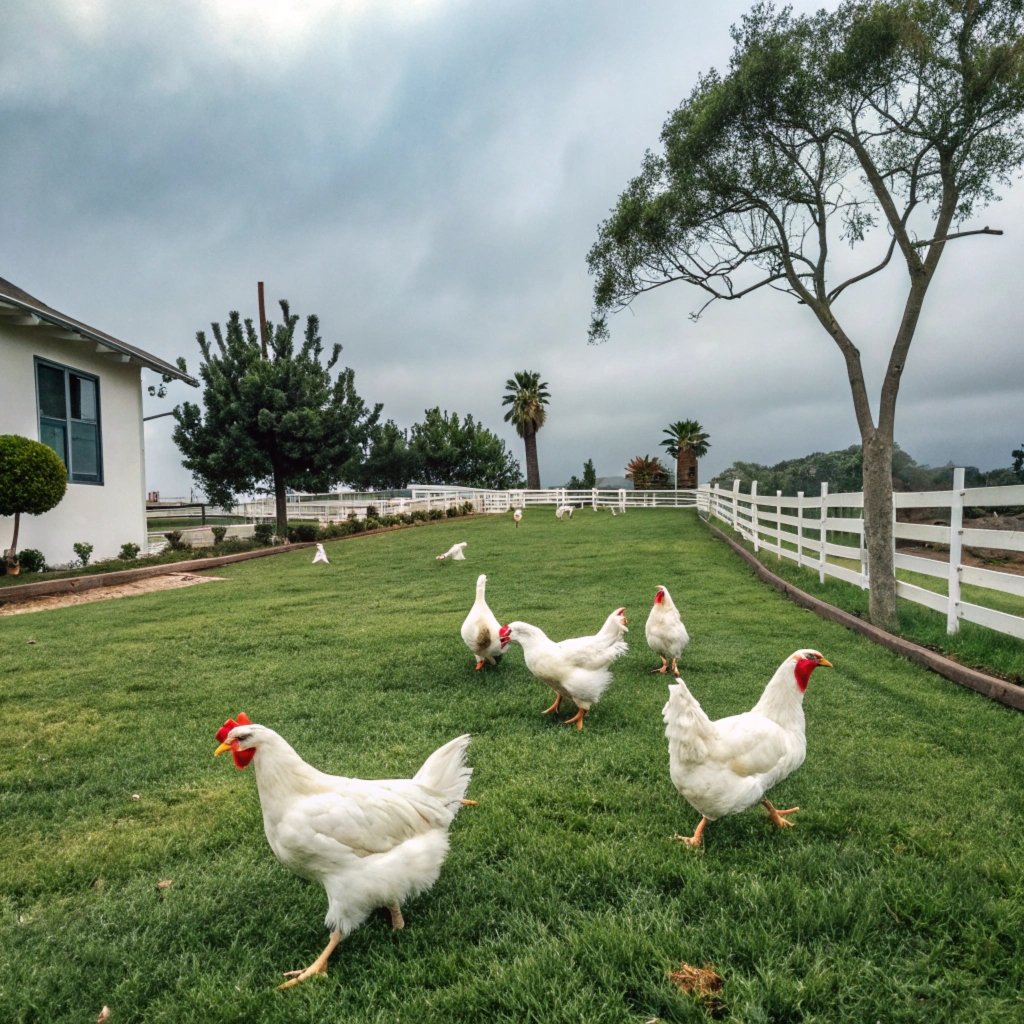
California White Chickens possess a unique appearance that sets them apart from other breeds.
Their predominantly white plumage is punctuated by subtle black flecks, particularly around the neck and tail areas. This distinctive coloration is a visual reminder of their mixed heritage.
With an upright stance and alert demeanor, these birds embody the Mediterranean breed appearance inherited from their Leghorn ancestry.
Their large, single combs are bright red and stand out against their white feathers, while their wattles are of average size and equally vibrant.
California Whites have clean legs with four toes, and their beaks are a pale horn color.
The roosters typically weigh around 7 pounds, while hens are slightly lighter at about 5.5 pounds. This medium size makes them manageable for backyard keepers while still providing a substantial presence in the coop.
Egg-cellent Layers: The Impressive Egg Production of California Whites
One of the most compelling reasons to keep California White Chickens is their extraordinary egg-laying capacity.
These feathered powerhouses can produce over 300 large, white eggs per year, rivaling and often surpassing the output of their Leghorn ancestors.
This translates to an average of 5 to 6 eggs per week, making them an excellent choice for families looking to maintain a steady supply of fresh eggs.
The hens typically start laying around 17 weeks of age, earlier than many other breeds. What’s particularly impressive about California Whites is not just the quantity but also the quality of their eggs.
The eggs are known for their large size and strong shells, attributes that are highly valued by both home cooks and small-scale egg producers.
This remarkable productivity, combined with their longevity as layers, makes California Whites a top choice for those seeking a reliable and prolific egg-laying breed.
Temperament and Behavior: The Personality of California Whites
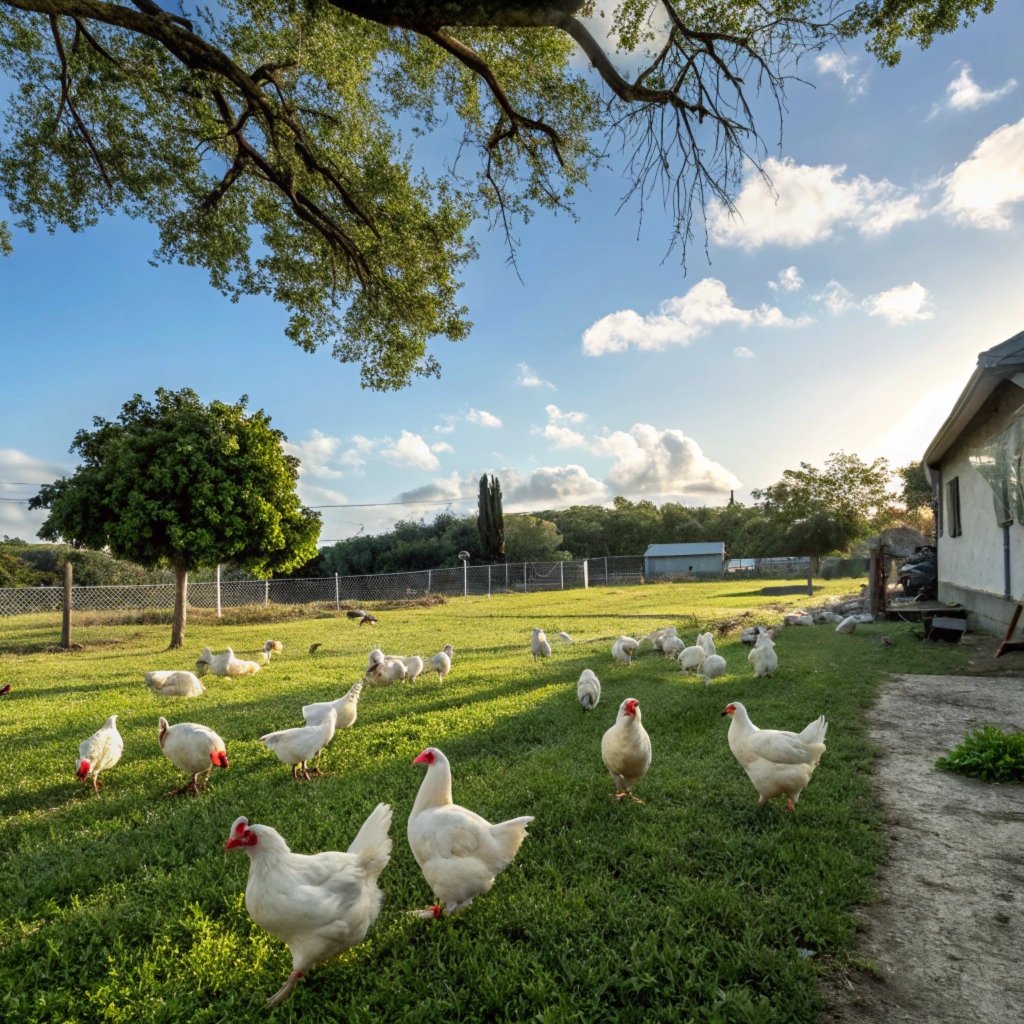
California White Chickens offer a delightful balance of energy and calmness, making them an ideal choice for various flock setups.
While they inherit some of the active nature of their Leghorn parentage, they are generally less flighty and more approachable than pure Leghorns.
These birds are known for their friendly disposition towards humans and their flock mates, though they maintain a level of independence that chicken keepers find appealing.
California Whites are not typically aggressive, which makes them suitable for mixed flocks and families with children.
Their adaptable nature allows them to thrive in both confined spaces and free-range environments, making them versatile additions to any backyard or small farm.
While not as cuddly as some breeds, California Whites can become quite tame with regular handling, especially if socialized from a young age.
Housing Requirements: Creating the Perfect Home for California Whites
Providing appropriate housing for California White Chickens is crucial for their well-being and productivity. These adaptable birds don’t require elaborate setups, but they do need a clean, well-ventilated coop with adequate space.
A general rule of thumb is to allow about 3-4 square feet of coop space per bird. The coop should include comfortable perches for roosting and nesting boxes for egg-laying, with one box for every 3-4 hens.
While California Whites tolerate confinement well, they appreciate an outdoor run or free-range area where they can engage in natural behaviors like scratching and foraging.
If possible, provide at least 8-10 square feet of run space per bird. The coop should be secure against predators and offer protection from extreme weather conditions.
Good ventilation is essential to prevent respiratory issues, but drafts should be avoided, especially in colder climates.
With their adaptability, California Whites can thrive in various housing setups, from urban backyards to rural farms.
Feeding Guide: Nourishing Your California White Flock
Proper nutrition is key to maintaining the health and egg-laying prowess of California White Chickens. These prolific layers require a well-balanced diet to support their high egg production.
A high-quality layer feed should form the foundation of their diet, providing the necessary proteins, vitamins, and minerals.
This should be supplemented with calcium sources like oyster shells to ensure strong eggshells. Fresh, clean water should be available at all times.
While California Whites are efficient foragers when given the opportunity, their diet can be enhanced with kitchen scraps, greens, and insects as treats.
However, treats should not exceed 10% of their total diet to maintain optimal health and egg production.
During molting or in times of stress, consider providing a protein boost to support feather regrowth and overall health. It’s important to adjust their feed based on age and season, offering more energy-dense foods during colder months.
Health and Common Issues: Keeping Your Flock in Top Shape
California White Chickens are generally robust and healthy, thanks to their hybrid vigor. However, like all chickens, they can be susceptible to certain health issues that require attention.
Regular health checks are essential to catch any problems early. Egg binding can occasionally occur due to their high egg production, so monitoring for signs of distress during laying is important.
They may also be prone to respiratory issues if kept in poorly ventilated conditions. Parasites such as lice, mites, and worms can affect California Whites, so implementing a regular deworming and parasite control program is advisable.
In colder climates, their large combs may be susceptible to frostbite, requiring extra protection during winter months.
Maintaining a clean coop, providing a balanced diet, and ensuring proper ventilation can prevent many common health issues.
While they are generally disease-resistant, vaccinations against common poultry diseases are recommended to maintain optimal health.
Breeding California White Chickens: Challenges and Considerations
Breeding California White Chickens presents unique challenges due to their hybrid nature. As a cross between White Leghorns and California Greys, California Whites do not breed true, meaning their offspring may not consistently display the same characteristics as the parents.
For those interested in breeding, it’s important to understand that maintaining the breed requires ongoing crossbreeding of the parent lines.
Selecting breeding stock should focus on birds that exemplify the best traits of the breed, including high egg production, good temperament, and proper physical characteristics.
The breeding process requires careful management, including providing appropriate nesting areas and ensuring a proper ratio of hens to roosters.
Incubation of eggs, whether natural or artificial, should be closely monitored. While breeding California Whites can be rewarding, it’s generally more complex than breeding pure breeds and may not be suitable for beginners.
Adaptability: Thriving in Various Environments
One of the standout features of California White Chickens is their remarkable adaptability to different environments.
These versatile birds can thrive in a wide range of climates and settings, from urban backyards to rural farms.
They handle both hot and cold weather reasonably well, though extreme temperatures may require some additional care.
In hot climates, providing shade and plenty of fresh water is crucial. During colder months, their large combs may need protection against frostbite.
California Whites are equally comfortable in confined spaces or free-range setups, making them suitable for various flock management styles.
Their ability to adapt to different living conditions makes them an excellent choice for first-time chicken keepers or those with limited space.
This adaptability, combined with their low-maintenance nature, contributes significantly to their growing popularity among backyard poultry enthusiasts.
Economic Benefits: The Financial Advantages of Raising California Whites
Raising California White Chickens can offer significant economic benefits for both hobbyists and small-scale farmers.
Their exceptional egg-laying capacity means a steady supply of eggs for personal consumption or small-scale sales.
With the potential to lay over 300 eggs per year, a small flock of California Whites can produce a substantial egg yield.
This high productivity makes them an excellent choice for those looking to offset household egg expenses or generate a small income from egg sales.
Additionally, their efficient feed conversion rate means they produce a high number of eggs relative to their feed consumption, making them cost-effective to maintain.
The birds’ hardiness and disease resistance can also lead to reduced veterinary costs compared to some other breeds.
For urban or suburban chicken keepers limited by local ordinances on flock size, California Whites’ prolific laying means maximum egg production from a minimal number of birds.
Comparing California Whites to Other Breeds: How They Stack Up
When comparing California White Chickens to other popular breeds, several factors stand out. In terms of egg production, they often outperform even their Leghorn ancestors, making them one of the top choices for egg-laying efficiency.
Unlike some heritage breeds that may lay fewer but more colorful eggs, California Whites produce a large quantity of standard white eggs.
Their temperament is generally calmer than pure Leghorns, making them easier to handle, yet they’re not as docile as breeds like Orpingtons or Brahmas.
In terms of size, they fall into the medium category, larger than Bantams but smaller than meat breeds like Jersey Giants.
Their adaptability to various climates and housing situations is superior to many specialized breeds.
While they may not win beauty contests like some ornamental breeds, their practical benefits in egg production and ease of care make them a top contender for those prioritizing functionality over aesthetics in their backyard flock.
Care and Maintenance: Keeping Your California Whites Happy and Healthy
Maintaining a healthy and productive flock of California White Chickens requires attention to several key areas.
Regular health checks are essential, including inspections for parasites, signs of illness, and overall condition.
Their coop should be cleaned frequently, with fresh bedding provided to maintain hygiene and prevent disease.
While California Whites are generally low-maintenance, they still benefit from routine grooming, especially during molting seasons.
Providing dust baths helps them keep their feathers clean and free from parasites. Nail trimming may occasionally be necessary, particularly for birds with limited foraging opportunities.
Balanced nutrition is crucial, with feed adjusted according to their life stage and egg-laying cycle.
Fresh water should always be available and changed daily. In colder climates, measures to prevent frostbite on their large combs may be necessary.
Regular interaction and observation will help you catch any potential issues early and ensure your California Whites remain happy and productive members of your flock.
The Future of California White Chickens in Poultry Farming
As the demand for efficient, adaptable, and productive chickens continues to grow, California White Chickens are poised to play an increasingly important role in the future of poultry farming.
Their exceptional egg-laying capabilities, combined with their adaptability to various environments, make them an attractive option for both small-scale and commercial operations.
The breed’s hybrid vigor contributes to its resilience and productivity, qualities that are highly valued in modern poultry farming.
As more people turn to backyard chicken keeping for fresh eggs and sustainable living, the California White’s ease of care and high yield make it a top contender for urban and suburban flocks.
However, the breed’s future also depends on responsible breeding practices to maintain its desirable traits.
While not recognized as a standard breed, the California White’s practical benefits ensure its continued popularity.
As poultry farming evolves to meet changing consumer demands and environmental considerations, breeds like the California White that offer efficiency and adaptability are likely to remain in high demand.
FAQs
How many eggs do California White Chickens lay per year?
California White Chickens are exceptional layers, typically producing over 300 large, white eggs per year. This translates to about 5-6 eggs per week, making them one of the most productive egg-laying breeds available.
Are California White Chickens good for beginners?
Yes, California White Chickens are excellent for beginners. Their low-maintenance nature, adaptability to various environments, and friendly temperament make them ideal for those new to chicken keeping.
How long do California White Chickens live?
With proper care, California White Chickens can live for 5-7 years on average. Some may live longer, but their egg production typically decreases after the first few years.
Can California White Chickens be kept in small backyards?
Absolutely. California Whites adapt well to confined spaces, making them suitable for small backyards. However, they do appreciate some outdoor space for foraging and exercise when possible.
Do California White Chickens require special care in winter?
While generally hardy, their large combs may be susceptible to frostbite in very cold climates. Providing a well-insulated coop and applying petroleum jelly to their combs can help protect them during harsh winters.
Are California White Chickens noisy?
California Whites are generally quieter than many other chicken breeds, making them a good choice for urban or suburban settings where noise might be a concern.
Can California White Chickens be used for meat production?
While primarily bred for egg production, California Whites can be used for meat. However, they are not as meaty as dedicated meat breeds, so they’re not the most efficient choice for this purpose.
How do California White Chickens interact with other breeds?
California Whites are generally peaceful and can coexist well with other chicken breeds. Their adaptable nature makes them suitable for mixed flocks.
What is the difference between California White and White Leghorn chickens?
While similar in appearance and egg-laying capacity, California Whites are typically calmer and more adaptable than pure White Leghorns. They also tend to lay for a longer period and are often considered friendlier.
Can California White Chickens fly?
Like most chickens, California Whites can fly short distances. While not as flighty as some breeds, they may attempt to clear low fences, so proper enclosure is important.

Hello, I’m Emily Price, the founder of Birds Affection. As a passionate bird enthusiast and spiritual seeker, I’ve always been fascinated by the symbolic meanings and mystical connections between birds and our lives. On this website, I share my knowledge and insights on the spiritual significance of various bird species, exploring their roles as messengers, guides, and teachers. Through my writing, I aim to inspire and educate others on the profound wisdom and beauty that birds bring to our world. Join me on this journey as we delve into the enchanting realm of bird symbolism and discover the hidden meanings behind these magnificent creatures.

